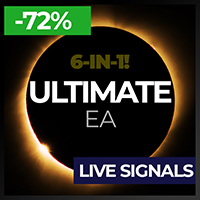Trading Robots for MetaTrader 4
Shopping cart
MetaTrader 4
Top Rated Products MT4
Overview
An advisor with atomic potential from the first days!
Monitoring
All signals are managed by our advisors, details are disclosed only to existing clients - after purchasing/renting any product.The advisor is based on chaos theory - the disorderly movement of the price. In the first strategy, the robot identifies moments when the price becomes most active and opens a grid of pending orders in the direction of the price. In the second strategy, pending orders are placed against the price movement. And finally, in the third strategy, work is carried out on the market without using pending orders.
Most of the time, the advisor is in standby mode, so you should not expect quick results from it. However, a long wait of even several weeks can pay off in just a few hours of active work. This is the whole highlight of the strategy. For a long time, the robot can probe the market and lose small batches of transactions, which is an integral part of the strategy. But as soon as it catches a good price impulse, the deposit can be increased many times over with just one such jerk.
As a result of a small readjustment, the strategy can be changed using hedging positions. As soon as a certain percentage of drawdown is reached, a position is opened in the opposite direction from the series with the total volume of all open positions + multiplication factor. If as a result the price does not change its direction, then the total profit becomes positive and as soon as it reaches the set percentage of profit, all positions are closed.
If after opening a hedging position the price reverses, a second hedging position is opened in the opposite direction from the last one, and so on until the entire series of transactions is closed with a set percentage of profit due to a larger volume. Usually during such price impulses the price quickly breaks out of the intended price corridor. So the chances of making a profit in this way are very high.
Options
- Settings:
- Trade_EA_Settings - trading using local advisor settings (without using the file system),
- Trade_File_Settings - trading using the file system settings (this can be much more convenient, easier and more efficient);
- Accountant - the advisor optimization mode, during the optimization of parameters in the strategy tester, the robot is launched in parallel on the chart in the "Accountant" mode to process the received data. As a result, the robot selects the received sets of settings and saves them to files. The advisor sorts and loads files ready for work in real time.
- Folder_Number - number of the folder with files;
- Auto_Magic - used exclusively in conjunction with the " Trade_File_Settings " parameter this function selects the best files with settings depending on the set priority "MagicNumber", so let's say if "MagicNumber = 1" , this will mean the highest priority and the robot will search on the server for the best file with settings (the best is the one that showed the best results in the strategy tester), then the next 2, 3, 4 and so on. It makes sense to open dozens of accounts and on each set the robot different priorities from 1 and higher and the robot will download and upload different files each time. The highest priority is relative and is not a fact that it will be the most profitable;
- MagicNumber - sets the priority of downloaded files and is also an identifier of positions, therefore it cannot be changed if the advisor has open positions;
- --------------------------
- Auto_Symbol - automatic selection of a currency pair for trading, according to the data obtained during testing. The robot will select the most promising currency pair according to the established priority starting with 1, then 2, 3 and so on.
- Auto_All - if enabled, then during the selection of a currency pair and assigning it a priority, the robot will take into account the overall result, otherwise the individual one.
- Switch_Drawdown - if greater than 0, then automatic currency selection begins only after reaching the drawdown percentage set here and after closing an unsuccessful series, until then the choice of currency remains yours.
- Symbol_Filter - allows you to exclude currency pairs for which a drawdown was recorded with a percentage of Switch_Drawdown, the robot then skips them during automatic selection.
- --------------------------
- n_Strategy:
- Strategy_0 - disable all strategies;
- Strategy_1 - pending orders for breakout;
- Strategy_2 - pending orders for a rebound;
- Strategy_3 - trading on the market.
- Strategy_Copy - if you disable this parameter, the "n_Strategy" option switches to manual control. So, let's say you have the "Trade_File_Settings" mode enabled and all settings are copied from the file, but you want to trade with these settings not on a breakout but on a rebound from levels or vice versa (i.e. in the opposite direction), in this case you disable this flag and manually set the "n_Strategy" trading mode;
- --------------------------
- Inp_Point - the multiplication factor of parameters that are calculated in points;
- --------------------------
- Turbo - if enabled, the robot will add pending orders based on signals immediately as existing pending orders are triggered, without waiting for open positions to close. This can seriously load the deposit, but the expected profit can also increase significantly;
- --------------------------
- RiskPercent - percentage of the deposit for automatic lot calculation;
- Lot - fixed lot (if RiskPercent=0);
- Multiplication - coefficient of multiplication of averaging positions;
- --------------------------
- Max_Loss - if greater than 0, then in case of a loss that exceeds the value specified here, the robot stops trading until further actions are specified. A red button will light up on the chart and if you press it, the blocking will occur and trading will continue, but it is recommended to re-optimize. By default, if the adviser detects and downloads a new set of files with settings, it will be blocked automatically.
- Equity_Percentage - calculation Max_Loss as a percentage of the deposit;
- Total_History - the number of days of history for which the trading result should be calculated, it is recommended to be no less than 30 days.
- -------------------------
- Close_Time_Min - early closing of positions after time has elapsed, the countdown is in seconds from the moment the positions are opened;
- -------------------------
- Spread - the maximum allowed spread, above which the robot does not trade;
- Slippage - permissible slippage;
- -------------------------
- Distance - distance for placing the first pending order;
- Pending_Orders - the number of simultaneously open pending orders;
- Divergence - the distance between orders;
- Expiration - the lifetime of pending orders;
- -------------------------
- Stop_Loss_Percentage - stop loss as a percentage of the deposit;
- Minimum_Stop_Loss - minimum distance to stop loss;
- Take_Profit_Percentage - take profit as a percentage of the deposit;
- Minimum_Take_Profit - minimum distance to take profit;
- --------------------------
- n_Signal:
- Signal_Candles - trading using candlestick analysis,
- Signal_Counter - trading on a price rollback from a given trend (on a pullback according to the rubber principle),
- Signal_Custom - trading using a built-in indicator based on the principle of oversold and overbought market conditions;
- ---------------------------
- Step - price measurement step (Signal_Candles);
- Power - time of price change in seconds (Signal_Candles);
- ---------------------------
- Period_MA - period of the MA indicator (Signal_Counter);
- Step_MA - the distance of the pull in pips (Signal_Counter);
- ----------------------------
- Use_Arrow - trade only at the moment of signal generation (Signal_Custom);
- Deviations - price deviation (Signal_Custom);
- ----------------------------
- Use_Trailing_Stop - use trailing stop;
- Trail_Time - trailing delay in seconds from the moment the position is opened;
- Trail_Start - start;
- Trail_Step - step;
- NoLoss - breakeven;
- Min_Profit_No_Loss - minimum breakeven profit;
- ----------------------------
- Averaging - averaging of open positions;
- Last_Price - if enabled, the price of the last position is taken, otherwise the extreme one;
- MaxTrades - maximum number of averaging positions;
- PipStep - distance between positions in pips;
- LotExponent - averaging volume multiplier;
- ----------------------------
- Use_Time - time filter;
- BeginTime - the beginning of a trading session;
- EndTime - end of trading session;
- ----------------------------
- Trailing_Profit - profit trailing in the deposit currency, so let's say if Trailing_Profit = 100 and a profit of 100 dollars is fixed on the account - the function will be activated, as a result, if the profit falls to 50 dollars, then all positions and orders will be closed forcibly. If after the function is activated, the price continues to move and the profit grows, then the closing amount will also grow. Thus, if the profit reaches an amount of approximately 300 dollars, then the closing amount will already be 150 dollars by that time, the closing amount on a price rollback will always be 50% of the maximum achieved;
- ----------------------------
- Protected_Amount - non-combustible deposit amount, if the equity drops to this value, all positions and orders will be closed forcibly and trading will stop. It is necessary to take into account that the amount specified here will not participate in trading, accordingly, you cannot specify a non-combustible amount of 100 dollars here if you only have a deposit of 100 dollars;
- Protected_Copy - copy the Protected_Amount value from a file (if using the settings file system) or locally;
- ----------------------------
- Count_Symbol_Max - the number of currency pairs that can be traded simultaneously. The robot counts the number of currency pairs for which positions are open, this is necessary to prevent deposit overload. Let's say 2 positions are open for EURUSD and 3 positions for GBPUSD, the function will return the value - 2. This means that there are only 2 currency pairs in operation;
- ----------------------------
- Percentage_Lock - percentage of the total volume of all open positions on the chart for placing the first lock order;
- Max_DD - the percentage of drawdown of the main series at which the first hedging position is opened;
- Corridor_Lock - corridor distance for hedging positions;
- Lot_Exponent_Lock - hedging position coefficient;
- Percentage_Profit_Lock - percentage of profit for closing all positions;
- Max_Trades_Lock - maximum number of hedging positions;
- Inp_Point - multiplication of pip parameters by a specified coefficient;
- i_Symbol - protection against accidental launch of the advisor on another symbol (the symbol is written here);
- i_Period - protection against accidental launch of the advisor on a different period (the period is specified here).
Automatic optimization block
- MultiLevelRecording - the number of folders with files, if 0, the settings will not be saved. During optimization, the adviser analyzes the results of each pass in the strategy tester and saves the settings with the best indicators in separate files. Files with settings (including the currency pair and chart period) are saved in a separate folder. However, according to the optimization results, positive results can be achieved with different settings, and no one knows which settings will be most effective in real market conditions. Therefore, it makes sense to save at least several combinations of settings, which can then be used on several accounts at once by distributing funds between them. This achieves risk diversification. While we can get a loss on one account, a profit is achieved on another account. In order to automate the process of saving settings in different variations, it is enough to increase the value of the MultiLevelRecording parameter (abbreviated name - MLR) by the desired amount. As a result, after saving the settings in one folder (for a certain currency pair with a certain chart period), the adviser will create a new folder for the next variation by increasing its number by one. The main folder number is the Folder_Number parameter, which contains all subfolders with the initial Magic_Number number. All subsequent folders have numbers - (Magic_Number + creation serial number). The number of each subsequent folder exceeds the previous one by one multiple (one digit).
- _1_Statistics - custom criteria for acceptability of settings in the form of a drop-down list. Select the criterion that, in your opinion, the result of acceptability of settings should correspond to. All results that do not correspond to this criterion will be automatically cut off:
- Initial deposit - the value of the initial deposit.
- Withdrawal - the amount of funds withdrawn from the account.
- Profit - net profit at the end of testing.
- Gross profit - total profit, the sum of all profitable (positive) trades. The value is greater than or equal to zero.
- Gross loss - total loss, the sum of all unprofitable (negative) trades. The value is less than or equal to zero.
- Maximal profit trade - maximum profit is the highest value among all profitable trades. The value is greater than or equal to zero.
- Maximal loss trade - maximum loss is the smallest value among all loss trades. the value is less than or equal to zero
- Maximal consecutive profit - the maximum profit in a sequence of profitable trades. The value is greater than or equal to zero.
- Maximal consecutive wins - total profit in the longest series of profitable trades.
- Maximal consecutive loss - the total loss in the longest series of losing trades.
- Maximal consecutive losses - the number of trades in the longest series of losing trades.
- minimum balance - minimum balance value.
- Maximal balance drawdown - the maximum balance drawdown in money. During trading, the balance can experience many drawdowns, the lar est value is taken.
- Balance drawdown percent - the balance drawdown in percent that was recorded at the moment of the maximum balance drawdown in money.
- Maximal relative balance drawdown - maximum balance drawdown in percent. During trading, the balance may experience multiple drawdowns, for each of which the relative drawdown value is recorded in percent. The largest value is returned.
- Relative balance drawdown percent - balance drawdown in money, which was recorded at the moment of the maximum balance drawdown in percent.
- Minimal equity - minimum value of equity.
- Maximal equIty drawdown - the maximum drawdown of funds in money. During trading, funds can experience many drawdowns, the largest value is taken.
- Equity drawdown percent - the drawdown of funds in percentage, which was recorded at the moment of the maximum drawdown of funds in money.
- Maximal relative equIty drawdown - maximum drawdown of funds in percent. During trading, funds can experience multiple drawdowns, for each of which the relative value of the drawdown in percent is recorded. The largest value is returned.
- Relative equIty drawdown percent - the drawdown of funds in money, which was recorded at the moment of the maximum drawdown of funds in percentage.
- Expected payoff - mathematical expectation of winning.
- Profit factor - profitability.
- Recovery factor - recovery factor.
- Sharpe ratio - Sharpe ratio.
- Minimal margin level - the minimum achieved value of the margin level.
- On tester result - the value of the calculated user optimization criterion.
- Deals - the number of completed transactions.
- Trades - number of trades.
- Profit trades - profitable trades.
- Loss trades - unprofitable trades.
- Short trades - short trades.
- Long trades - long trades.
- Profit short trades - short profitable trades.
- Profit long trades - long profitable trades.
- Trades of maximal consecutive profit - trades with maximum consecutive profit.
- Maximal consecutive wins count - the maximum number of wins in a row.
- Trades of maximal consecutive loss - trades with maximum consecutive loss.
- Maximal consecutive losses count - the maximum number of consecutive losses.
- Average consecutive wins - the average length of a profitable series of trades.
- Average consecutive losses - the average length of a losing series of trades.
- _1_Stat - more or less. Let's say if you selected drawdown as a criterion, then this flag should be set to less (the less drawdown, the better). And if the criterion is profit factor, then naturally more (the more profit factor, the better).
- Statistics_1_ - minimum/maximum value of the criterion at which the settings are accepted.
- _2_Statistics, _3_Statistics - similar parameters...
- Auto_Switch - if you turn it off, the files with the settings will not be written automatically during optimization, they will be written during testing. Thus, the selection of the best settings is carried out manually with your participation.
- Pause_Pass - if greater than 0, the robot will not write files with settings in a row, it will skip the number of variations specified here, this is done in order to diversify the options with settings as much as possible.
- Instant_Processing - if enabled, the robot will analyze the received settings directly during optimization, otherwise during testing. If it is necessary to conduct forward testing of the received settings, it is necessary to disable. During forward testing, the robot will test all selected files with settings in turn, delete those that did not pass forward testing and analyze all the remaining ones with automatic construction of a vector from best to worst.
- --------------------------
- Forward - forward testing, if enabled, the advisor will conduct forward testing directly during optimization. From the set date, inside the advisor, functions are enabled that calculate critically important indicators, such as profit (fixed in the deposit currency), relative drawdown (in percent), profit factor, mathematical expectation, number of trades, all indicators below relate exclusively to forward testing from the date Forward_Time;
- Forward_Time - forward testing start date;
- Forward_Profit - the profit received in the deposit's hard currency at which the settings are accepted;
- Opt_Drawdown - relative drawdown as a percentage of the deposit within which the settings are accepted;
- Opt_Profit_Factor - profit factor at which the settings are accepted;
- Opt_Expected_Payoff - the expected value at which the settings are accepted;
- Total_Trades - number of trades at which the settings are accepted;
- --------------------------
- Month_Loss - if greater than -1, then the adviser will accept only those settings that show a stable deposit growth from cycle to cycle. A cycle can last from one minute to one month. If you set the value to 0, then in this case not a single loss cycle is allowed, this is a very strict criterion, under which it will be difficult or even impossible for a strategy tester to select settings. This largely depends on the duration of the cycles, if the cycle lasts a month, then there are only 12 of them in a year and this is incomparably easier than an hourly cycle, where there are only 24 cycles in a day. Especially if zero cycles are not allowed, in other words, downtime.
- Switch_Period - duration of cycles;
- Zero_Result - whether to consider idle time as a negative result in cycles; if enabled, it will be much more difficult for the tester to select settings, especially for short cycles.
Notes read carefully
- The robot was created by an active trader and programmer with extensive experience.
- You shouldn't try to figure out its settings right away, at first glance it seems complicated, in fact it will be very easy to manage after you understand the basic principles of its operation at the user level.
- There is also a unique opportunity use this robot for free, both temporarily and permanently, under the affiliate program. Another name for this advisor Osa.
- At first, it is strongly recommended to use only ready-made files with settings downloaded from our server. It takes time before you learn how to optimize the robot yourself. Especially for this there is a utility, which searches and downloads files from our server automatically, with a frequency of one hour. It is necessary to run on a parallel schedule, in the utility settings select Atmos.
Why Users Leave Negative Reviews on MQL5: Motives Analysis
Introduction
The MQL5 platform is one of the largest trading platforms for MetaTrader advisors and indicators. However, as on any trading platform, there are cases of deliberate posting of negative reviews.
Main reasons for posting fake reviews
-
Competition between sellers of trading robots. Competitors may leave negative reviews to reduce sales of certain products.
-
Fraudulent schemes for the purpose of extortion. Fraudsters leave negative reviews and demand money for their removal.
-
Personal dislike to a specific seller or product. Some users may be biased for subjective reasons.
-
Technical misunderstandings. Not all users have sufficient knowledge to correctly install and configure trading robots.
How to spot a fake review
-
Lack of specificity. The review does not clearly describe the problem.
-
Emotional coloring. Predominance of negative emotions without objective reasons.
-
Mass attack. A series of identical reviews from different accounts.
-
Inconsistency of facts. A contradiction between the description of the problem and the actual capabilities of the product.
- Suspicious accounts. Reviews from recently registered users with no purchase history.
How to protect yourself when choosing an advisor
Integrated approach The choice of a trading robot includes:
-
Self-testing of the product.
-
Correct setup advisor.
-
Monitoring results of work.
-
Contact the developer if necessary.
Conclusion
False negative reviews are a common problem on trading platforms. However, knowing the signs of fake reviews and following the recommendations for their analysis will help you make informed decisions when choosing MQL5 products. Remember that a constructive approach to evaluating reviews and carefully analyzing the information will help you avoid negative consequences and make the right choice.
Support
All questions and comments in the social network "Telegram", on other resources I do not comment on messages and do not answer questions, in order to save time and concentrate information on one channel.








